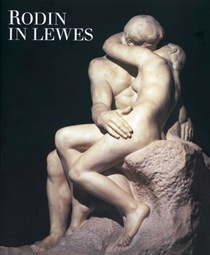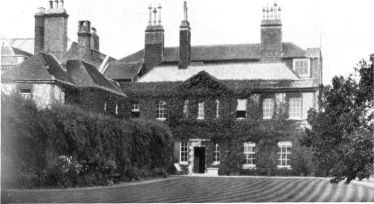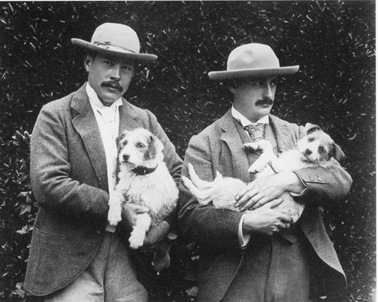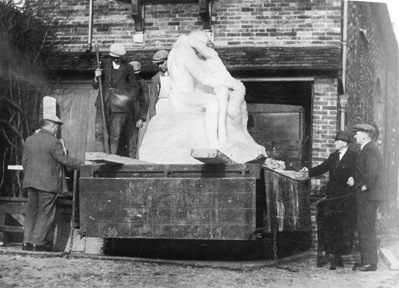The biggest project in my life so far was to persuade the Tate Gallery to lend me The Kiss – a national treasure and one of the world’s most famous statues – for an exhibition in Lewes. There are many different versions of The Kiss, including four larger-than-life marble statues. One of these was commissioned around 1900 by two gay guys – E.P. Warren and John Marshall - who lived in Lewes. The statue came to our small town and was there for more than 30 years before it left and eventually ended up in the Tate Gallery. Rodin came for supper in Lewes one night.
The project took me nine years – virtually all of my 40s. The story has come again to focus because the Tate has just lent The Kiss to the new Turner Gallery in Margate, Kent. As a result I’ve been on the local tv twice this last week talking about our project back in 1999. Above is the cover of the exhibition catalogue we produced, which included this essay I wrote that tells the fascinating back story.
THE KISS: A LEWES STORY
There are many strange stories to be unearthed in the ancient hill town of Lewes, the county town of East Sussex. For many of its inhabitants, the past remains a subject of everyday conversation, alongside the present gossip and scandals in which every small town abounds.
But there is one story which, for reasons that will become clear, has been effectively buried for almost seventy years. It is the story of the intermingled destinies of a gay Hellenic brotherhood, one of the greatest sculptors of the modern age, perhaps his most controversial work - subsequently adopted worldwide as a symbol of romantic love -and a venerable house which carries the name of the town and provides a link to much of its history.
The back view of Lewes House from the garden [Lewes District Council Archive]
Lewes House, currently the headquarters of the local District Council, sits on a parcel of land that dates back to the reign of Edward III. Mulberry trees, planted by law to help the silk trade, date from the Elizabethan period. The Italian Garden, recorded on a map of 1703, has gone, but the sundial and grotto remain. The house itself, with its former stables and servants' quarters, remains virtually as it was when a young American, E.P. Warren, first saw it in 1889 and decided to make it his home.
Warren recorded his first impressions in a letter of 22 October 1889: 'The house that may do here is huge, old and not cheap. It has only three or four sunny rooms (this number might be just sufficient) and then a goodly number of large north rooms. It is in the centre of Lewes and yet has a quiet garden, a big kitchen garden, a paddock, greenhouse and stables ad lib. Downs accessible and green wooded country as well. You can also have a walk by the seaside. I am much inclined to it.'
It was here that Warren was to establish a 'brotherhood' of like-minded aesthetes, archaeologists, artists and scholars dedicated to establishing a major antiquarian collecting business, driven by his own deep love of Greek culture.
Edward Perry Warren, born in 1860, was one of six children of a wealthy paper manufacturer, Samuel Warren. Edward (Ned) grew up in the prestigious surroundings of a grand house in Boston, Massachusetts, in an atmosphere almost oppressively devoted to the arts. His mother, Susan, was an obsessive art collector, and several members of the family were involved with the birth and development of the Museum of Fine Arts in Boston, to which they made substantial donations.
The Warren family historian Martin Green gives us a striking picture of the young boy: 'Ned was indeed "nervous". He grew up evasive, devious, unreliable, a hypochondriac but with plenty of energy and pertinacity. Perhaps his most striking feature was his failure or refusal to be boyish - and later, manly. When his brothers played Indians, he ran around by himself in a toga.' Openly afraid of women, Ned was bullied for his 'sissiness', for his sexual 'abnormality', for his 'failure in manly sports and tastes'. He grew up scornful of the social and intellectual pretensions of the Bostonian elite, and developed instead a passion for ancient Greece and its manly virtues, which included the love of young men. Boston at that period had a lively bohemian culture, in which a 'gay' and 'queer' society - favoured adjectives of the fin-de-siecle - was beginning to emerge. The city was considered the Athens of America and one of the aesthetic capitals of the world.
It was in Oxford however that Warren's developing tastes found expression. Oxford in the 1880s engaged in the new passion for beauty and aesthetics expounded by John Ruskin and Walter Pater and embodied by Oscar Wilde, who had recently graduated from Magdalen College.
When Warren arrived at New College in 1883, he found much that he liked. He devoted himself to classical studies, especially art and archaeology, despite eye problems that were steadily to worsen. The following year he recorded in his unfinished autobiography: '. . . I was asking myself whether I could be excused from the world's work of business or other terrors - could justifiably live without earning money provided I spent little.' He was also 'on the look-out for affections between my own sex, real affections.' This he was to find at New College that same year of 1884, when he met John Marshall, an archaeologist and scholar from Liverpool who was to become Warren's long-term companion and the great love of his life.
Edward Perry Warren and John Marshall with their Sealyham terriers ay Lewes House. Photo: Edward Reeves
During the autumn term of 1885, unable to study as a result of his eye trouble, Warren made his first trip to Greece. He had in mind several plans as to his future direction. His mother was in Europe and fond of travelling, and he thought he could get his health back by accompanying her and acting as an adviser in buying works of art.
In 1888 Warren's father died, leaving an estate worth $1.9 million, to be administered by a Trust established to run for thirty-three years. One effect of this, Green writes, 'was to tie the Warrens together for life, financially and therefore in other ways, and to make them dependent on each other but above all on [his elder brother] Sam.' It was an arrangement that would lead to tragedy.
Warren was now determined to establish his Hellenic shrine and, Green says, 'had decided that the Hellenic idea was unintelligible without art - meaning above all Greek sculpture, but also vases, coins, intaglios, and cameos.' Newly wealthy, and with a new love, Warren discovered Lewes House.
Warren and Marshall turned Lewes House into a professional collecting enterprise, processing vast quantities of antiquities in their search for the fine, the rare and the ancient. They brought together both objects and people, and the house became the hub of a network linking many major institutions and museums, dealers and collectors, artists, artisans and classicists.
The dining room at Lewes House. [Lewes District Council Archive]
Lewes House had studies and bedrooms for eight, stabling for three Arab stallions, and was home to a pack of dogs including St. Bernards, Sealyham terriers and a boarhound. The atmosphere was described variously as being that of a pagan monastery or the court of a small German princedom. Candles were the only light allowed in the rooms, except in the halls, bathrooms, and passages. The painter William Rothenstein recalled: 'Meals were served at a great oaken table, dark and polished, on which stood splendid old silver. The rooms were full of handsome antique furniture, of Greek bronzes and marbles.' Over all this presided Ned Warren, a set of amber worry beads clutched constantly in his left hand.
Among several Fellows of New College who helped to get the enterprise off the ground was Matthew Stewart Pritchard, a former barrister whom Warren had met in Rome. Pritchard had been a member of Oscar Wilde's circle, as had another key member of the group, the painter John Fothergill.
Fothergill was introduced to Wilde in 1895, the year of his trial and imprisonment, by Robbie Ross, Wilde's first lover. It was through Ross that Fothergill met Warren in 1898. Fothergill joined forces with Warren and William Rothenstein - who was later to introduce Warren to Rodin - to finance a new London gallery, the Carfax.
Through the Carfax, Warren and his associates established a link between the antique and the modern, at a significant time in art history. The work of the moderns would find a place alongside the Greek treasures in Lewes House, where the artists themselves were entertained, among them Roger Fry and Augustus John, Eric Gill and Auguste Rodin, from all of whom Warren purchased work. Fry, acting as a link between the Bloomsbury Group and Warren, introduced Warren to Gill, which led to the purchase of Ecstasy, a stone relief of a heterosexual coupling - a work lost for many years, now in the* collection of the Tate Gallery, alongside Rodin's The Kiss.
The antiquarian enterprise was at its peak for ten years from 1892. By 1895, Warren and Marshall had established a flat in Rome to help coordinate their rapidly expanding collecting operation, which allowed them to travel widely over the Continent and the Mediterranean in their search for treasures.
According to David Sox, the author of Bachelors of Art, the story of what he calls the 'Lewes House Brotherhood', they had 'complete control of the market in classical antiquities. Almost everything that was good, whether a new find or an old one, came to [them] for first refusal. Competition had all but ceased.'
The business really took off when they struck an unorthodox deal with Edward Robinson, curator of antiquities at the Boston Museum of Fine Arts. Warren was granted £1,000 annually for five years by the family Trust to purchase antiquities. This sum was to be matched by Boston, and purchases not approved by the museum would be retained by Warren without charge. As a result of this deal, ninety per cent of the museum's current holdings of classical antiquities came as gifts or purchases from the Warren/Marshall team. Through this, Warren felt that he could both express his contempt for Boston and improve their collection, while also confirming his status in the family.
Thus the various members of Lewes House, and several local tradesmen, found themselves involved in collecting, cleaning, restoring, photographing, insuring and repackaging the stream of objects that arrived each week during this period.
Classical pieces included a head of Aphrodite from Chios - considered one of the finest Greek sculptures ever made - a bronze head of the Roman Empress Livia, a torso of Hermes, and many other desirable ancient Greek, Etruscan and Roman pieces. From the Renaissance came a Madonna and Child from the school of Donatello, a tondo by Filippino Lippi, and Adam and Eve by Lucas Cranach, now on show at the Courtauld Gallery, London. Modern works included a giant portrait of the Lord Mayor of Liverpool by Augustus John, the controversial stone relief by Gill, and several works by Rodin, the greatest of which was a marble version of Le Baiser ('The Kiss').
Few people are unaware of The Kiss, Rodin's most famous work alongside The Thinker. The sculpture has been made in many materials and at many scales, in bronze, plaster and terracotta versions, ranging from ones that can be held in the hand to three over life-size marble carvings, housed in London, Paris and Copenhagen. (A fourth inferior version, produced from Rodin's studio after his death, is in Philadelphia.)
The Lewes Kiss began life when Rothenstein saw the first version of the sculpture at the 1898 Salon in Paris. Convinced that Warren would like its 'pagan sexuality', and knowing that Rodin could use the money, Rothenstein effected a contract through the Carfax Gallery on 12 November 1900.
The price was £1,000, and it was a condition of the contract that the genitals of the man must be distinct and complete. Warren subsequently came to see the work in progress in Paris and visited Rodin at his home in Meudon, outside Paris. In 1903 Rothenstein persuaded Rodin to come to Lewes to see Warren's Greek collection, which apparently impressed him greatly.
The following year, on 28 November, The Kiss left Paris en route to Lewes. Exactly how the four and a half ton marble travelled to Lewes we cannot be sure, but when it finally arrived in the town it was, according to the Sussex Express & Herald:'... placed in the coach house, the only part of Mr Warren's residence in which there was room for such a massive piece of sculpture.' Did Warren miscalculate its size? We may never know. It seems strange to commission such an expensive and prestigious work only to sequester it, out of sight, in a space full of bric-a-brac at the far end of a stable block. There it was to sit for the next ten years apart from a brief outing to an exhibition in London, and in none of the literature or visitor's accounts so far discovered is there any mention of it during this period.
In 1906 Rodin requested that Warren lend The Kiss to the International Society's annual exhibition at the New Gallery in Regent Street, London. Rodin had been elected President of the Society in 1903 and was a regular exhibitor. The appearance of the sculpture was to make it famous in Britain for the first time. As far as we know, after the exhibition The Kiss was returned to the stable block at Lewes House, where it remained until 1914.
For reasons that again are not known, Warren then offered to lend it to Lewes Town Council. It was to be placed in the Town Hall, at the South End of the Assembly Room. Negotiations began in January and were concluded by May 1914; on 4 August war was declared. The Kiss was moved from Lewes House to the Town Hall by trolley, using three men and four horses, and was ' installed in the Assembly Room on 2 December 1914.
The same week, the Assembly Room was opened as a reading, writing and recreation room for troops billeted in the town. Regular boxing matches were staged in the same room, where, according to the recollections of one resident (recorded by the Borough librarian), the sculpture was 'used as a vantage point from which to obtain a better view of the boxing ... at one match, the audience pressed so closely round the statue that you could see the sweat running down the woman's back.'
Then, early in 1915, The Kiss was suddenly wrapped in canvas and marked off with a guard rail. Whatever the cause of the cover-up, it was not written about in either the Council minutes or the press of the day. Press reports from 1929 refer to 'susceptibilities being offended' and to the undraped figures of The Kiss 'as offending the proprieties'. The search for more evidence will no doubt continue, but the upshot was that the Town Council returned the statue, saying only that the room did 'not lend itself to such a noble piece of statuary.' On 26 February 1917, The Kiss was once more taken to the stable block where it was to remain for a further sixteen years.
The years following the commissioning of The Kiss marked the end of Warren's Hellenic dream. Pritchard befriended Warren's brother Sam and left Lewes to join the staff of the Boston Museum, a decision Warren described as 'going over to the enemy'. More surprisingly, John Marshall formed an attachment with a spinster cousin of Warren's who had come to stay in Lewes House, whom he subsequently married.
In September 1901, on the death of his mother, Warren returned to Boston. There the long-simmering disagreements between him and Sam intensified over the future of the museum, resulting in an acrimonious trial and ultimately in Sam's suicide. In the last year of his life, having nursed his old friend John Marshall through his final days, Warren revisited Oxford and Lewes, as well as finding the energy to complete his magnum opus, A Defense ofUranian Love. He died on 28 December 1928 in a London nursing home.
The Kiss being loaded ready for its move to Cheltenham in 1952 [Lewes District Council Archive]
On Warren's death, Lewes House and its contents were inherited by his secretary Harry Asa Thomas, who auctioned them in October 1929. The Kiss failed to reach its asking price and was yet again returned to the stables. A few years later, Thomas offered it to any provincial gallery that would pay the costs of transport and insurance. Cheltenham responded, when the museum's curator remembered Rodin's connection with the town: he had spent five weeks there in 1914. The sculpture remained in Cheltenham for three years before reaching its current destination, the Tate Gallery.
In 1952, Sir John Rothenstein, son of William Rothenstein who had arranged the original deal between Rodin and Warren, launched a public subscription to save the piece for the nation. The Kiss was purchased in 1953 and is now one of the Tate's most popular attractions. Its return to Lewes marks what we hope will be a revival of interest in Rodin's relationship with Britain, and in the activities and lives of Ned Warren and the other colourful occupants of Lewes House at the turn of the century.
Sources:
Osbert Burdett and E.H. Goddard, Edward Perry Warren: Biography of a Connoisseur, Christophers, London, 1941
Martin Green, The Mount Vernon Street Warrens: A Boston Story, 1860-1910, Charles Scribners, New York, 1989
David $ox, Bachelors of Art: Edward Perry Warren & The Lewes House Brotherhood, Fourth Estate, London, 1991
Antoinette Le Normand-Romain, Le Baiser de Rodin, Reunion des Musées Nationaux/Musée Rodin, Paris, 1995
Additional material from the East Sussex County Records Office and the Lewes District Council Archive



![clip_image002[6] clip_image002[6]](http://lh4.ggpht.com/-HURmPaope4U/TpH6_Z8xdgI/AAAAAAAAEeI/cDXnlv-uxUQ/clip_image0026_thumb2.jpg?imgmax=800)

6 comments:
Thank you for your article. I am currently researching for a PhD looking at Warren's Classical collection and his sexual politics. Could you tell me if it is still possible to get a copy of the guide this is taken from? Thanks.
JM: happy to send one. Contact me via my personal e-mail (check Profile)
JM: happy to send one. Contact me via my personal e-mail (check Profile)
The reason it was covered up in Lewes Town Hall & subsequently removed back to the stables of Lewes House is straight forwards, a local femist campaigner and head mistress of a Lewes High school, Miss Kate Fowler-Tutt believed it would inflame the passions of the soldiers billeted locally and she did not wish for her girls to be exposed to such things. In 1921 she successfully got the council to sand down the prominent nipples on the new statue of britania that was part of the new war memorial located at the top of School Hill, Lewes
I would very much like to hear from Mick Symes what is the evidence for the two statements about Kate Fowler Tutt. John Miles does not say, in his piece above from the 1999 exhibition catalogue, that she was involved in the covering up, though she is mentioned in the acknowledgement to W E Clarke, the jewellers, for their sponsorship. The war memorial issue is a new one to me.
A lovely photo has been found in the Reeves archive showing soldiers dining in the Corn Exchange centre rear of this picture clearly shows "The Kiss" covered up. the picture was recently exhibited in the Tourist information office window to co-incide with Reeves latest lightbox exhibition, Lewes 1916. strategically placed was also a photo of K F-T overlooking the war memorial. The matter of covering the statute is documented, but now the photgraphic proof exists
Post a Comment